【精品】外研版高中英语必修五:module 4 教案(单元全套)
外研社必修五module4carnival全单元教案资料
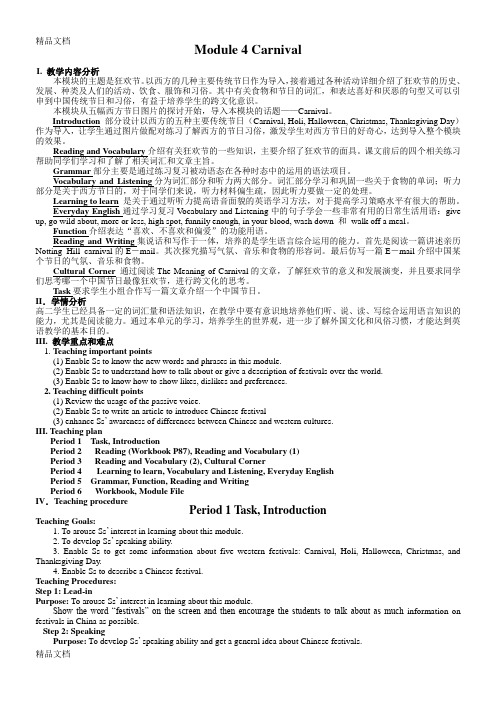
精品文档Module 4 CarnivalI. 教学内容分析本模块的主题是狂欢节。
以西方的几种主要传统节日作为导入,接着通过各种活动详细介绍了狂欢节的历史、发展、种类及人们的活动、饮食、服饰和习俗。
其中有关食物和节日的词汇,和表达喜好和厌恶的句型又可以引申到中国传统节日和习俗,有益于培养学生的跨文化意识。
本模块从五幅西方节日图片的探讨开始,导入本模块的话题——Carnival。
Introduction 部分设计以西方的五种主要传统节日(Carnival, Holi, Halloween, Christmas, Thanksgiving Day)作为导入,让学生通过图片做配对练习了解西方的节日习俗,激发学生对西方节日的好奇心,达到导入整个模块的效果。
Reading and Vocabulary介绍有关狂欢节的一些知识,主要介绍了狂欢节的面具。
课文前后的四个相关练习帮助同学们学习和了解了相关词汇和文章主旨。
Grammar部分主要是通过练习复习被动语态在各种时态中的运用的语法项目。
Vocabulary and Listening分为词汇部分和听力两大部分。
词汇部分学习和巩固一些关于食物的单词;听力部分是关于西方节日的,对于同学们来说,听力材料偏生疏,因此听力要做一定的处理。
Learning to learn是关于通过听听力提高语音面貌的英语学习方法,对于提高学习策略水平有很大的帮助。
Everyday English通过学习复习Vocabulary and Listening中的句子学会一些非常有用的日常生活用语:give up, go wild about, more or less, high spot, funnily enough, in your blood, wash down 和walk off a meal。
Function介绍表达“喜欢、不喜欢和偏爱”的功能用语。
Reading and Writing集说话和写作于一体,培养的是学生语言综合运用的能力。
外研版高中英语必修5教案 Module 4 Carnival

Module 4 Carnival 教案Period Four Cultural corner & Reading in workbookP87 Step 1 Lead inStep 2 Fast ReadingRead the passage quickly and put the main ideas of the five paragraphs into the right order.( ) The slave trade brought millions of black people to the new world.( ) We can understand what carnival is all about by reading the history of America and the meeting of two cultures.( ) Carnival became a celebration of freedom.( ) As time went on, carnival became a way of uniting different communities and now it has become a celebration of life itself.( ) The slaves were forced to watch their European masters to celebrate carnival and then they began to hold carnival with their own features.Step 3 Careful ReadingRead the passage again and choose the best answer.1. A larger number of slaves were taken to America because ___________.A. they had to make a living thereB. large farms need labor force in AmericaC. there were no labor force in AmericaD. America was richer than Africa2. Walking around a village with masks and singing songs means _______ in Africantraditions.. A. they are in high spirits B. they have got something goodC. that will bring them good luckD. to frighten ghosts away3. Nowadays carnival means______________A. remembering the pastB. honoring the harvestC. drinking, dancing, eating etc.D. uniting of different communitiesStep 4 Consolidation1. The arrival of Europeans in America, and the opening of huge farms and plantationsto grow cotton, fruit and vegetables, meant________________________(急需)for people to work on them.lions of people ________________(被强行带走)from their homes in Africa and ________(运送) to the New World to________________(当奴隶) .3.When the slave trade _____________(被废除)in 1838 the former slaves ____________(沿袭了)the carnival.4.They painted their faces white, _________(模仿)their masters and ________ _______ ______(取笑) them.5._________________________(随着时间的流逝), the white inhabitants of the islands began to ________ _________ ________(加入) the carnival, too.Step 4 Post-readingRead the passage “Christmas Traditions” in the workbook on page 87 and finish doing activities 7&8.Step 5 Discussion: Describing a Chinese festival (eg: the Spring Festival)Work in groups. Choose a Chinese festival. Discuss with things and write notes:●where and when it is celebrated●what happens during the festival●costumes and foodStep 5 HomeworkWrite a description of the festival for visitors to China.。
外研版高中英语必修5 Module4 Grammar and Vocabulary精品教案

Module4 Grammar and Vocabulary精品教案Teaching objectives:1. To learn new words and expressions and learn how to use them.2. To review of the passive voices.Difficult and important points:1. Get the students to know how to use passive voices:一般现在时和一般过去时的被动语态2. The usage of: hide, pretend, memory, wander, come to an end, dress up; consist of be good for ,date from.Teaching procedures:Step 1. RevisionRead the sentences and find out what grammar are they?1. Is the room cleaned every day?2. We were woken up by a loud noise during the night.3. Something must be done before it is too late.4. Have you heard the news? The President has been shot?5. The car was three years old but hadn’t been used very much.6. There’s somebody walking behind us. I thin k we are being followed.Step 2. Presentation—被动语态被动语态的基本形式是: be +过去分词根据时态的不同, be的形式有所变化. (1) 一般现在时的被动语态: am/is /are+过去分词(口语可用get/become或got /became)(2) 一般过去时的被动语态:was /were+过去分词被动语态的基本用法:不知道或没有必要提到动作的执行者是谁时用被动语态.强调或突出动作的承受者常用被动语态.(有时可省略).使用被动语态应注意的几个问题.(1) 主动变被动时双宾语的变化. 看下列例句eg: 我朋友在我生日时送我一本有趣的书.My friend gave me an interesting book on my birthday.— An interesting book was given to me (by my friend) on my birthday.—I was given an interesting book (by my friend) on my birthday.(2) 主动变被动时,宾补成主补(位置不变);作宾补的省略to的不定时在被动语态中应加to.eg: 老板让他整天工作.The boss made him work all day long.— He was made to work all day long (by the boss).(3) 短语动词变被动语态时,勿要掉”尾巴”.eg: 孩子们被他照顾的很好.—The children were taken good care of ( by her).eg: 要注意一下你的发音和拼写.—Your pronunciation and spelling should be paid attention to.(4) 情态动词和be going to, be to, be sure to ,used to, have to, had better等结构变被动语态,只需将它们后面的动词原形变为be +过去分词。
高中英语 Module4备课参考教案(1)外研版必修5-外研版高二必修5英语教案

英语必修5外研版Module4备课参考教案〔1〕Module 4 Carnival------Previewing(教师用书独具)●课标技能要求初步掌握本课文中的词汇,浅层次理解课文,了解相关的背景知识。
●教学目标本课时主要是通过学生对学案所给出的内容的学习,了解本课文中所出现的词汇,初步了解课文以及相关的背景知识,对下一堂课对课文的全面理解起到一个铺垫作用。
●教学地位本模块题材内容为“狂欢节〞,并引入与此有关的词汇,如中外节日的名称。
通过了解上述内容,要求学生掌握有关的词汇,培养有关的语言技能。
比较中外节日的差异,并从中分析、了解东西方文化的特点,增强跨文化交际的意识。
(教师用书独具)●新课导入建议T:Do you know anything about Thanksgiving Day? Where is it celebrated? When? And why? (如果有学生能回答,就让学生回答。
如果学生回答不了,教师就给出答案。
这个过程其实是学生的学习过程。
)T: Can you name some more western festivals? (鼓励提供更多的西方节日的名称并根据准备好的录像作简单的介绍。
如Christmas, Holi, Halloween, etc.)T: Who can name any Chinese festivals? (把全班分成两大组,开展比赛。
看哪个组能说出更多的中国节日名称,在黑板上写下节日名称,并记录学生得分。
) T:We have learned many festivals both Chinese and the Western.Can you guess what this festival is: People wear masks and special clothes.They dress up for this festival.Ss:Carnival.T: Yes.Today we will learn another festival—Carnival.It originates from Europe,and during these days, people often love wearing special clothes and masks for it.Read the passage and match the main idea with every paragraph.…●教学流程设计导入新课。
外研版必修5 Module4教案

外研版必修5 Module4教案Module Four CarnivalPeriod OneTeaching content:Introduction & Reading and VocabularyTeaching important points:1.Learn some new words and phrases about carnival.2.Help the students understand the passage and learn about carnival better.3.Help the students learn some difficult language points.4.Train the students` reading skill.Teaching difficult points:1.Help them make sense of the new words and phrases.2.Help them improve reading ability and understand the passage better.3.Help them master language points in this passage.Teaching procedures:Step 1 Lead-inWhen we were children,we all looked forward to festivals.Why?Because festivals mean eating delicious food,wearing beautiful clothes,visiting relatives,getting red envelopes,doing what we want to do and so on.In aword,festivals mean happy time.This module,we will talk about thetopic:Carnival.Step 2 Introduction1.Activity 2 on P31Now please name some Chinese festivals and say when they are celebrated.春节:The Spring Festival(Lunar January 1)元宵节:The Lantern Festival(Lunar January 15)清明节:Ching Ming Festival/Tomb-sweeping Day(Solar April 4-6)端午节:Dragon Boat Festival(Lunar May 5)七夕节:Double Seventh Festival(Lunar July 7)中秋节:Mid-Autumn Festival(Lunar August 15)重阳节:Double Ninth Festival(Lunar September 9)除夕:New Year` Eve(Lunar December 31)【清明节】清明是我国的二十四节气之一。
高中英语外研版必修5【教学设计】Module 4

Module 4 Carnival本模块以Carnival 为话题,介绍狂欢节的历史、发展、种类及人们的活动、饮食和习俗,并由此引导学生联想、讨论中国的节日,旨在通过学习本模块使学生掌握有关节日和食物的词汇、句型,从而不但了解外国的狂欢节,而且对我国的节日也有进一步了解,进而拓展社会文化背景、增加跨国文化知识;使学生巩固表达喜好的方式,复习并掌握被动语态的用法;能够根据要求描写一个中国的节日,能表达自己的观点和想法。
1. 掌握并记忆本课的重点词汇和短语。
2. 培养学生的阅读能力,训练学生阅读速度,查读的阅读技巧;训练学生学会找主题句,归纳文章主旨,运用想象,联想,学会用英语思考的能力 。
3. 学生复习并掌握被动语态在各种时态中的使用。
4. 学会用英语来介绍节日相关的文章。
【过程与方法目标】1. 通过让学生图片视频等形式了解不同文化下的节日以及其形成的原因。
2. 通过自主探究,小组活动等方面来引导学生掌握这个单元的单词,文章和知识点,从而形成与节日相关的文章。
【情感态度价值观目标】1. 了解不同的节日以及不同的文化。
2. 能够用英语写一篇关于节日的文章。
【教学重点】1. 学习和掌握本课生词。
2. 让学生掌握被动语态在各种时态中的运用。
【教学难点】1.多层次的训练阅读能力,提高阅读水平2.怎样让学生灵活使用词汇、短语和句型形成有质量的文章。
PPT、录音机等Step 1 Introduction and reading1. Lead-inT: How many festivals you know?Ss: Thanksgiving Day/Christmas/ Spring Festival/ Mother’s Day...T: Do you know the following festival? Now please look at the photos below and answer the questions.What is the person wearing?Do you know what festival it is?Anything else do you know about this festival?Ss: She is wearing a mask, maybe to celebrate some important things.T: Great guessing. Carnival is celebrated on February 21-23 each year. Let’s enjoy some beautiful pictures of the carnival in Venice.2.while-readingT: please read the passage quickly and match the main idea for each paragraph.Ss: Para. 1 for D, Par. 2 for C….T: great. Read the passage again and answer the questionsWhere did carnival begin?What did people usually do in the most famous carnival in Venice?According to the laws, what were people not allowed to do?Who revived carnival?Why does nobody take the masks off?Ss: It began in Europe….。
外研版高二英语必修5Module4Carnival教案
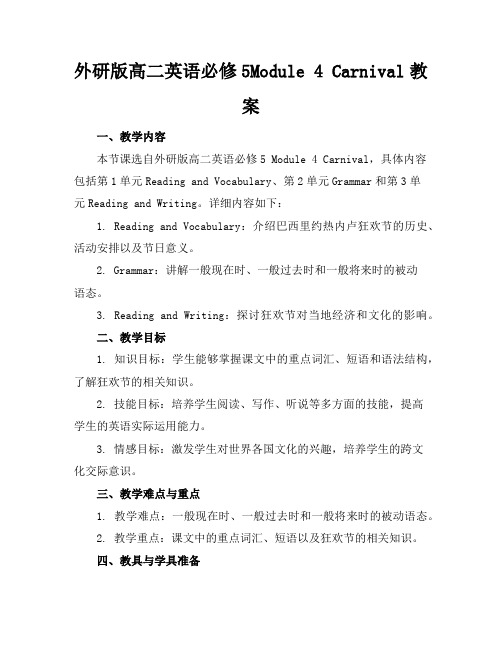
外研版高二英语必修5Module 4 Carnival教案一、教学内容本节课选自外研版高二英语必修5 Module 4 Carnival,具体内容包括第1单元Reading and Vocabulary、第2单元Grammar和第3单元Reading and Writing。
详细内容如下:1. Reading and Vocabulary:介绍巴西里约热内卢狂欢节的历史、活动安排以及节日意义。
2. Grammar:讲解一般现在时、一般过去时和一般将来时的被动语态。
3. Reading and Writing:探讨狂欢节对当地经济和文化的影响。
二、教学目标1. 知识目标:学生能够掌握课文中的重点词汇、短语和语法结构,了解狂欢节的相关知识。
2. 技能目标:培养学生阅读、写作、听说等多方面的技能,提高学生的英语实际运用能力。
3. 情感目标:激发学生对世界各国文化的兴趣,培养学生的跨文化交际意识。
三、教学难点与重点1. 教学难点:一般现在时、一般过去时和一般将来时的被动语态。
2. 教学重点:课文中的重点词汇、短语以及狂欢节的相关知识。
四、教具与学具准备1. 教具:多媒体课件、黑板、粉笔。
2. 学具:教材、笔记本、字典。
五、教学过程1. 导入:通过展示巴西里约热内卢狂欢节的图片和视频,引发学生对狂欢节的兴趣,为新课的学习做好铺垫。
2. 阅读理解:学生自主阅读课文,完成相关练习,了解狂欢节的历史、活动安排和意义。
3. 语法讲解:教师讲解一般现在时、一般过去时和一般将来时的被动语态,并举例说明。
4. 例题讲解:分析教材中的例题,引导学生运用所学的语法知识进行改写句子。
5. 随堂练习:学生完成课堂练习,巩固所学知识。
6. 小组讨论:学生分组讨论狂欢节对当地经济和文化的影响,并进行汇报。
六、板书设计1. 课文Carnival2. 重点词汇:history、schedule、economy、culture3. 语法结构:被动语态(一般现在时、一般过去时、一般将来时)七、作业设计1. 作业题目:(1)用被动语态改写下列句子。
高中英语外研版高中必修5Module4Carnival-教学设计

高中英语写作教学设计主题语境:人与社会——传统节日语篇类型:介绍性语篇教学内容分析和设计思路:本堂课的主题是“人与社会——传统节日”,涉及三个成型语篇,第一篇是关于印度传统节日Holi(胡里节)一篇说明文,第二篇是中国传统节日春节的风俗的一个听力语篇,第三篇是学生自己创作的介绍春节的语段组合成的一个语篇,主要目的是让学本堂课学到的东西能运用到写作中去。
本堂课的总体设计思路主要有三条线,第一:通过介绍印度传统节日Holi,让学生对介绍传统节日要素有所理解,知道如何向外国朋友介绍咱们中国的传统节日。
第二:通过对本堂课的学习,学生能积累一些描述春节的单词,短语和句型。
第三:通过对国中国传统节日的学习,深刻理解中国优秀的传统文化,让学生能成为中国文化的传播者。
学情分析:四川省南江县长赤中学地处农村,该班学生也都来自农村,相对于城市学生,他们英语的听、说、读、写的能力相对欠缺,尤其是听、说、写的能力,但是经过一年多时间的学习,孩子们的这些学科能力有所提高,本堂课也是基于他们的基础而设计的,可操作性强。
本堂课的目的是让他们积累关于春节的表达,掌握从哪些方面去介绍春节,进一步提升他们的写作能力和英语学科素养。
教学目标:学科素养:1.提取语篇大意,梳理文章结构。
2.明白介绍节日的基本要素,积累春节的相关表达,写一篇介绍春节的短文。
核心素养:深刻理解中国优秀的传统文化,培养优秀传统文化的自信。
教学重点:1.介绍节日的基本要素2.积累相关的表达教学难点:写好一篇介绍春节的文章和语言素养的提升。
教学方法:独立学习和合作探究。
教学反思:板书设计:B5M4 CarnivalReading and writingA festivalplace time meaning origin customs。
高中英语 Module4方案一精品教案(4)外研版必修5
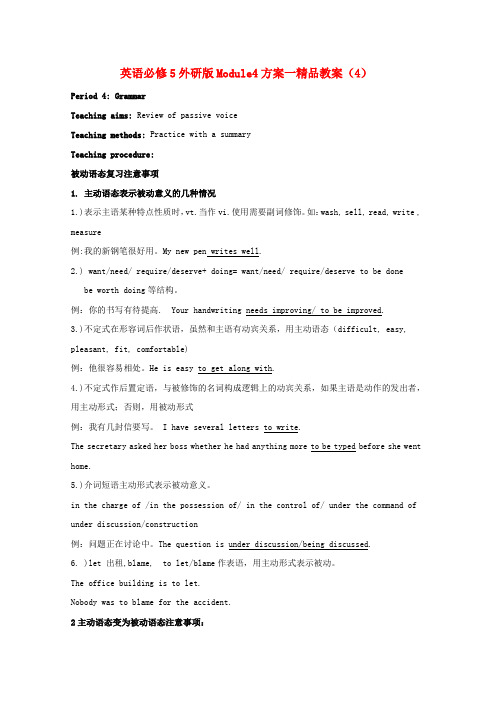
英语必修5外研版Module4方案一精品教案(4)Period 4:GrammarTeaching aims: Review of passive voiceTeaching methods: Practice with a summaryTeaching procedure:被动语态复习注意事项1. 主动语态表示被动意义的几种情况1.)表示主语某种特点性质时,vt.当作vi.使用需要副词修饰。
如:wash, sell, read, write , measure例:我的新钢笔很好用。
My new pen writes well.2.) want/need/ require/deserve+ doing= want/need/ require/deserve to be donebe worth doing等结构。
例:你的书写有待提高. Your handwriting needs improving/ to be improved. 3.)不定式在形容词后作状语,虽然和主语有动宾关系,用主动语态(difficult, easy, pleasant, fit, comfortable)例:他很容易相处。
He is easy to get along with.4.)不定式作后置定语,与被修饰的名词构成逻辑上的动宾关系,如果主语是动作的发出者,用主动形式;否则,用被动形式例:我有几封信要写。
I have several letters to write.The secretary asked her boss whether he had anything more to be typed before she went home.5.)介词短语主动形式表示被动意义。
in the charge of /in the possession of/ in the control of/ under the command of under discussion/construction例:问题正在讨论中。
外研版高中英语必修五:module 4 教案(单元全套)【精校版】

外研版高中英语必修五:module 4 教案(单元全套)【精校版】Paragraph 2: The history of carnival.Paragraph 3: ___ carnival.Paragraph 4: ___.Step 5.Detailed-readingRead ___.1.What is carnival?2.Where did carnival originate from?3.What did people do during carnival?4.What are some nal activities during carnival?5.Why ___?Step 6.Group workDivide the class into groups and ask them to ___.Step 7.nSummarize what we have ___。
Revised:Module 4 Carnivald One___ Aims:1.___ festivals.2.___' ___.3.___ Carnival.Important and Difficult Points:1.To help students comprehend the history of Carnival.2.___.___:Step 1.nReview the new words in the passage.Step 2.n1.Divide the class into two groups to list Chinese and Western ___.2.Match the ___ 31.Step 3.Lead-inIntroduce Carnival。
a ___.Step 4.Fast-readingMatch the main idea with each paragraph.Step 5.Detailed-reading___'s meaning。
高中英语 Module4方案一精品教案(1)外研版必修5
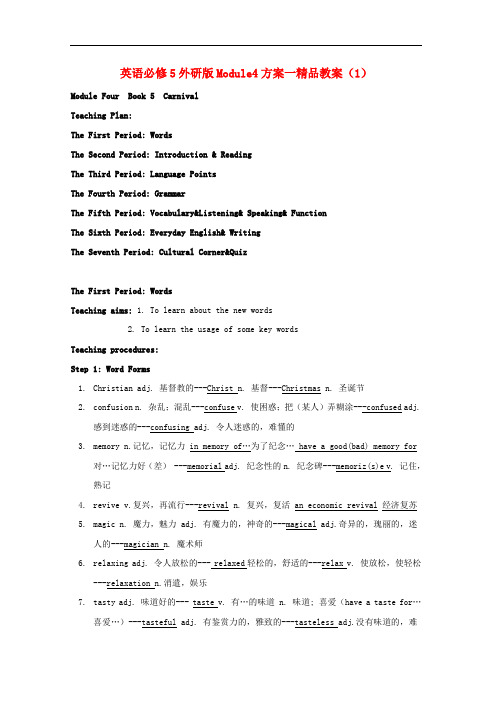
英语必修5外研版Module4方案一精品教案(1)Module Four Book 5 CarnivalTeaching Plan:The First Period: WordsThe Second Period: Introduction & ReadingThe Third Period: Language PointsThe Fourth Period: GrammarThe Fifth Period: Vocabulary&Listening& Speaking& FunctionThe Sixth Period: Everyday English& WritingThe Seventh Period: Cultural Corner&QuizThe First Period: WordsTeaching aims: 1. To learn about the new words2. To learn the usage of some key wordsTeaching procedures:Step 1: Word Forms1.Christian adj. 基督教的---Christ n. 基督---Christmas n. 圣诞节2.confusion n. 杂乱;混乱---confuse v. 使困惑;把(某人)弄糊涂---confused adj.感到迷惑的---confusing adj. 令人迷惑的,难懂的3.memory n.记忆,记忆力 in memory of…为了纪念… have a good(bad) memory for对…记忆力好(差) ---memorial adj. 纪念性的n. 纪念碑---memoriz(s)e v. 记住,熟记4.revive v.复兴,再流行---revival n. 复兴,复活 an economic revival 经济复苏5.magic n. 魔力,魅力 adj. 有魔力的,神奇的---magical adj.奇异的,瑰丽的,迷人的---magician n. 魔术师6.relaxing adj. 令人放松的--- relaxed轻松的,舒适的---relax v. 使放松,使轻松---relaxation n.消遣,娱乐7.tasty adj. 味道好的--- taste v. 有…的味道 n. 味道; 喜爱(have a taste for…喜爱…)---tasteful adj. 有鉴赏力的,雅致的---tasteless adj.没有味道的,难吃的8.import v.引进,进口 n.进口---export v. & n. 出口9.celebration n. 庆典,庆祝(in celebration of…为…举行庆祝活动)---celebratev. 庆祝(celebrate Christmas 庆祝圣诞节)10.unite v. 联合--- united adj. 团结的,联合的---unity n.团结,联合---union 工会;联盟11.origin n. 起源---original adj.起先的,最初的;新颖的,独特的(the original 原文,原著)---originally adv. 最初,原先 ---originate v. 起源(originatein/from/with 源自于)12.transport v. & n.运输,运送;运输工具--- transportation n.运输---transportern.运输者13.council n.地方会议 the State Council 国务院 the UN Security Council 联合国安理会Step 2: Word Study1.hide v (hid- hidden; hiding) hidden adj. 隐藏着的1)be in a secret place; put something in a secret place躲藏,掩藏;2)not tell someone about something隐瞒Useful expressions:hiding place 隐藏处/藏身地hide sth. from sb. 向某人隐瞒某事have nothing to hide 没什么可隐瞒的,光明磊落Crouching Tiger, Hidden Dragon 卧虎藏龙1)Hidden/ Hiding themselves in some machines on the network, some computer virusesoften attack other computers in secret/by surprise.一些病毒匿藏于网络上的一些机器中,经常出其不意的攻击其他机器。
高中英语 Module4方案一精品教案(5)外研版必修5
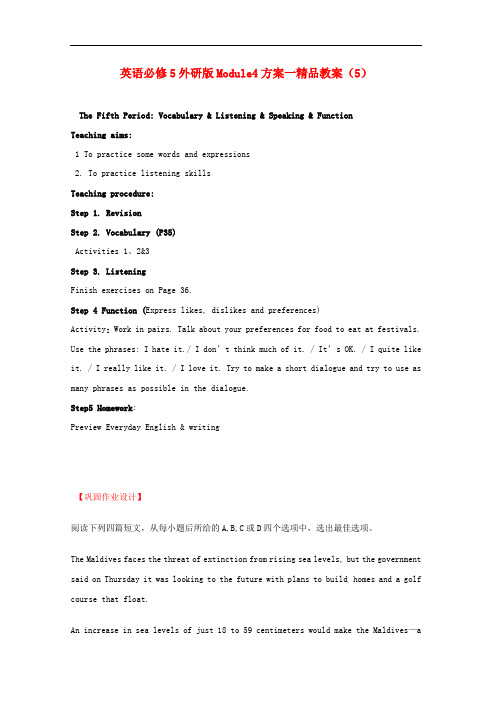
英语必修5外研版Module4方案一精品教案(5)The Fifth Period: Vocabulary & Listening & Speaking & FunctionTeaching aims:1 To practice some words and expressions2. To practice listening skillsTeaching procedure:Step 1. RevisionStep 2. Vocabulary (P35)Activities 1、2&3Step 3. ListeningFinish exercises on Page 36.Step 4 Function (Express likes, dislikes and preferences)Activity: Work in pairs. Talk about your preferences for food to eat at festivals. Use the phrases: I hate it./ I don’t think much of it. / It’s OK. / I quite like it. / I really like it. / I love it. Try to make a short dialogue and try to use as many phrases as possible in the dialogue.Step5 Homework:Preview Everyday English & writing【巩固作业设计】阅读下列四篇短文,从每小题后所给的A,B,C或D四个选项中,选出最佳选项。
The Maldives faces the threat of extinction from rising sea levels, but the government said on Thursday it was looking to the future with plans to build homes and a golf course that float.An increase in sea levels of just 18 to 59 centimeters would make the Maldives—anation of tiny coral islands in the Indian Ocean—virtually uninhabitable by 2100, the UN’s climate change panel has warned.President Mohamed Nasheed has vowed a fight for survival, and last month he signed a deal with a Dutch company to study proposals for a floating structure that could support a conference centre, homes and an 18-hole golf course.“It is still early stages and we are awaiting a report on the practicality,” a government official who declined to be named said.The company, Dutch Docklands, is currently building floating developments in the Netherlands and Dubai. There was no immediate comment from the firm but its website said it undertook projects that make “land from water by providing large-scale floating constructions to create si milar conditions as on land”.The Maldives began to work on an artificial island known as the Hulhumale near the crowded capital island of Male in 1997 and more than 30,000 people have been settled there to ease congestion. The city, which has a population of 100,000, is already protected from rising sea levels by a 30-million-dollar sea wall, and the government is considering increasingly imaginative ways to combat climate change.Nasheed, who staged the world’s first underwater cabinet meeting in Octobe r to highlight his people’s serious and difficult situation, has even spoken of buying land elsewhere in the world to enable Maldivians to relocate if their homes are completed covered.He has also promised to turn his nation into a model for the rest of the world by becoming “carbon neutral” by 2020. His plan involves ending fossil fuel use and powering all vehicles and buildings from “green” sources such as burning coconut husks.1. Why do you think Mohamed Nasheed chose Dutch Docklands?A. Because it has experience in building floating structure.B. Because it has a good fame throughout the world.C. Because it charged much less than other companies.D. Because it supports building floating structures in the world.2. The Hulhumale was built with the purpose of .A. attracting more visitorsB. making it a new capitalC. making the capital less crowdedD. fighting against climate change3. According to the last two paragraphs, Nasheed is a person who .A. has succeeded in buying land abroadB. is more than well-knownC. has thought more for his nationD. has stopped using fossil fuel4. The underlined word “vowed” in paragraph 3 can be replaced by.A. endedB. promisedC. failedD. weighed【参考答案】1—4、ACCB。
高中英语 Module4备课参考教案(4)外研版必修5-外研版高二必修5英语教案
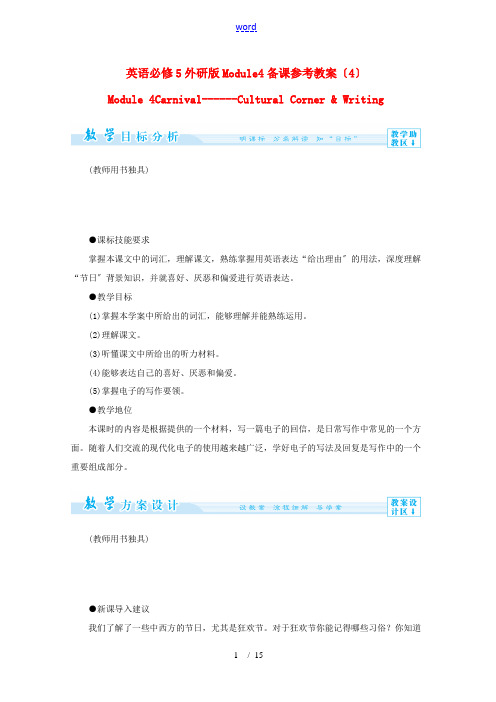
英语必修5外研版Module4备课参考教案〔4〕Module 4Carnival------Cultural Corner & Writing (教师用书独具)●课标技能要求掌握本课文中的词汇,理解课文,熟练掌握用英语表达“给出理由〞的用法,深度理解“节日〞背景知识,并就喜好、厌恶和偏爱进行英语表达。
●教学目标(1)掌握本学案中所给出的词汇,能够理解并能熟练运用。
(2)理解课文。
(3)听懂课文中所给出的听力材料。
(4)能够表达自己的喜好、厌恶和偏爱。
(5)掌握电子的写作要领。
●教学地位本课时的内容是根据提供的一个材料,写一篇电子的回信,是日常写作中常见的一个方面。
随着人们交流的现代化电子的使用越来越广泛,学好电子的写法及回复是写作中的一个重要组成部分。
(教师用书独具)●新课导入建议我们了解了一些中西方的节日,尤其是狂欢节。
对于狂欢节你能记得哪些习俗?你知道狂欢节的起源和意义吗?那么本课我们就狂欢节的起源和意义进行更深层次的了解和探讨,进一步介绍它的演变和发展。
●教学流程设计检查上堂课所布置的作业。
→导入新课。
→学生快速阅读课文(见课本第39页)并根据学案所设置的问题做出判断。
→学生就学案中的问题相互交换意见。
老师指导学生统一答案。
→让学生再次仔细阅读课文,并完成学案中“语篇理解〞部分(见学案第55-56页)。
→学生共同讨论师生统一答案。
→学生完成“要点讲练〞部分(见学案第56-58页)。
→学生共同讨论,并让学生发表各自见解,最后统一答案。
→错误!→错误!→错误!→老师布置作业:让学生课下做“模块归纳提升〞部分(见学案第59页)和Workbook 第87页第6、7题,第88页第8题。
(对应学生用书第55页)Ⅰ.判断正误阅读P39课文,判断正(T)误(F)1.The slave trade lasted more than two hundred years.( )2.Walking round a village wearing masks and singing was a British tradition.( )3.Musical bands were created for carnival before the slave trade.( ) 4.The meaning of carnival changed as time went on.( )[答案] 1.T 2.F 3.F 4.TⅡ.语篇理解阅读 P39的 Cultural Corner部分,从每题所给的3个选项中选出最正确答案1.At the very beginning, the slaves imitated their masters to.A.worship their GodB.make fun of themC.enjoy themselves2.Walking around a village with masks and singing songs meansin African traditions.A.they are in high spiritsB.they have got something goodC.that will bring them good luck3.Nowadays carnival means.A.uniting of different munitiesB.honoring the harvestC.remembering the past4.A large number of slaves were taken to America because.A.they had to make a living thereB.large farms need labor forceC.there were no labor force in America[答案] 1.B 2.C 3.A 4.B(对应学生用书第56页)1.relaxing adj.使人放松的Calypso is great—it's exciting and relaxing at the same time! (教材P38) 卡吕普索太棒了,它能让你既兴奋又放松!I find cooking very relaxing.我发现烹饪可以令人非常放松。
- 1、下载文档前请自行甄别文档内容的完整性,平台不提供额外的编辑、内容补充、找答案等附加服务。
- 2、"仅部分预览"的文档,不可在线预览部分如存在完整性等问题,可反馈申请退款(可完整预览的文档不适用该条件!)。
- 3、如文档侵犯您的权益,请联系客服反馈,我们会尽快为您处理(人工客服工作时间:9:00-18:30)。
外研版英语精品资料Module 4 CarnivalPeriod OneTeaching aims:1. To revise Chinese and western festivals.2. To develop the students reading ability.3. To understand what is about Carnival.Important and difficult points:1 Get the students to understand the history of carnival.2 Get the students to describe the festivals in groups.Teaching procedures:Step 1. Revision.Read the new words of this passage.Step 2. Introduction1. We have learned many festivals both Chinese and the Western. What festivals do you know?Divide the class into 2 groups. One group is for Chinese Festivals, the other group is for Western festivals.Make a list of them on the blackboard..2. Turn to Page 31—Match the festivals with the description.Step 3. Lead-inToday we will learn another festival ---- Carnival. It originates from Europe, and during these days, people often love wearing special clothes and masks for it.Step 4. Fast-readingMatch the main idea with every paragraph.Paragraph 1 A meaning of carnival and how it was celebratedParagraph 2 B the law about wearing masksParagraph 3 C general impression of carnivalParagraph 4 D how it is celebrate today in Venice and the feature of itParagraph 5 E carnival in Venice and the problem it causedParagraph 6 F the revival of the tradition of celebrating it.(Answers: 1—6 CAEBFD)Step 5. Further-readingRead the passage and answer the questions.1. Where does Carnival come from? What does it mean?2. When was it celebrated?3. Where was the most famous Carnival in Europe?4. How long did the first Carnival in Venice last? What about now?5. Did the government of Venice encourage the wearing of masks?6. Who started the Carnival again, tourists or students?(Answers: 1. “Carnival”comes from two Latin words, meaning “no more meat”. 2. It began just after Christmas. 3. The most famous carnival in Europe was in Venice. 4. At the beginning, it lasted for just one day. 5. No. 6. The students started the Carnival. )Step 6. VocabularyActivity 1: Read through the words in the box and have the students repeat them individually.Ask the students to complete the task individually, then check with a partner.Check the answers together:(Answers: 1. confusion 2. excitement 3. mask 4. mystery 5. magic 6. costume 7. crowd8. tradition 9. atmosphere)Activity 2: Choose the correct meanings of the words and phrases.Check the answers one by one.(Answers: 1—4 babb 5—8 abbb)Step 7. DiscussionDiscuss in groups of four.1. What is the feature of carnival in Venice?2. Which is your favourite festival?Step 8. Homework1. Workbook—on Page 87.Read the passage and match the headings with the text.2. Write a short passage about your favorite festival.Period TwoTeaching aims:1. To listen to the description about western customs.2. To express likes, dislikes and preferences:(1) I love doing…;(2) I don’t like…; I hate…; I dislike…; I don’t care much for(3) I prefer…to…;I prefer doing …(4) I’d rather…than…(5) I an interested in…3. To learn several phra ses.Difficult and important points:1. Get the students to express likes and dislikes2. Learn to use the phrases: give up; go wild ;more or less; high spot; funnily enough; in your blood; wash down; walk offTeaching procedures:Step 1. RevisionCheck the homework.—Ask several students to read the short passage with the name of My Favorite Festival.Step 2. Vocabulary1. Read the words about food.2. Now say which things you eat at a festival.3. Practice.Activity 2: Find these things in the box in Activity 1.(1) Two type of meat ( )(2) a food that consists of a tube of skin containing meat mixed with herbs. ( )(3) five vegetables ( )(4) two ingredients for making a cake ( )(Answers: (1) pork and chicken (2) sausages (3) beans, cabbages, garlic, onion, peas (4) flour, eggs)Step 3. ListeningBefore listening—Look at the photos in Activity 4 and tell them every picture meaning a special festival..While listening—Listen to the tape twice and match the names of the festivals with the photos.After Listening:Complete the tableStep 4. Everyday English1. Read the sentences and choose the correct meaning of the words and phrases.2. Check the answers one by one. (1)-b (2) a (3) b (4)a (5) b (6) a (7)a (8)b3. Explain the words and phrases.(1)give up sth. =don’t have it any more(2) go/wild with joy 欣喜若狂(3) more or less =approximately (opposite)exactly.Eg: That is approximately correct.(4) high spot= the best part(5) be/run in sb.`s blood = be /run in the blood. 生来就有的(因遗传或环境影响)eg; Most of my family are teachers, it runs in the blood.(6) wash down a meal = have a drinkwalk off a meal = help the food go down by walking.Step 5. Function1. Match the sentences with the speakers. Say what they are speaking about.(1)Caitlin: King Cake(2)Maria: Feijoada(3) Stefan: saugages(4) Cameron: traditional Jamaican food –chicken with rice and peas.2. Number the phrases from the most negative to the most positive(1) Ask the students to do this individually.(2) Call the answers back from the whole class, one at a time, from 1--6(3) Write down them on the blackboard:3. Work in pairs. Discuss your preferences for food to eat at festival. Use the phrases in Ac tivity2.(1) Read the example with the class.(2) Pair the students to discuss their preferences.(3) Circulate and monitor their production.Step 6. HomeworkFinish off the workbook.Period ThreeTeaching aims:1. To learn more about carnival.2. To teach them how to write an e-mail.3. To develop the students’ reading skills.Difficult and important points:1. Get the students to learn to write an e-mail.2. Get the students to understand some important sentences.Teaching procedures:Step 1. RevisionRead the words and have a dictation.Step 2. Lead-inWhat do you remember about carnival?Where did it start first?Step 3. Fast-reading:Read and underline the topic sentences ( use your own words ) about every paragraph. Paragraph1: We can understand what carnival is all about by reading the history of America and the meeting of two cultures.Paragraph2: The slave trade brought millions of black people to the new world.Paragraph3: The slaves were forced to watch their European masters to celebrate carnival and then they began to hold carnival with their own features.Paragraph4: Carnival became a celebration of freedom.Paragraph5: As time went on, carnival became a way of uniting different communities and now it has become a celebration of life itself.Step 4. Further reading1. What did marked the beginning of the slave trade?2. How were millions of people taken to work as slaves?3. How did the slaves begin to hold their own carnival in Trinidad?4. When was the slave trade abolished?5. How was carnival changed when the slave trade was abolished?6. When did carnival become a way to unite different communities?(Answers: 1 That the arrival of European in America, and the opening of huge farms and plantations to grow cotton, fruit and vegetables, meant there was an immediate need to people to work on them marked the beginning of the slave trades. 2 Millions of people were taken by force from their homes in America and transported to the New World to work as slaves? 3. They painted their faces white, imitating their masters and making fun of them. 4. The slave trade was abolished in 1838. 5. It became more colourful and more exciting than it had been before. 6. As people forgot their everyday problems and enjoyed themselves eating, drinking, and dancing.)Step 5. Several phrases(1) by force (2) be forced to do (3)make fun of sb. (4) bring good luck(5) take over (6) take part in (7) become a celebration of freedom (8) with the time passing Step 6. Discussion1. What is the meaning of carnival?2. Which Chinese festival is most like carnival?Step 7. Reading and writingActivity1. Read the email and number the things in the order you read them1. Read through the things with the whole class and make sure that they understand them all.2. Ask them to read the email and order the things individually, then check with a partner.3. Call back the answers from the whole class, in order.(Answers: 1. the atmosphere at the festival 2. the music 3. the food 4. what the writer’s doin g 5. what the writer’s going to do)Activity2. Underline the adjectives used to describe.1. the atmosphere: noisy/ colourful2. the music: great/ exciting/ relaxing3. the food: good/ tastyActivity3 Write an email from a Chinese f estival. Make sure of the details about:1. the atmosphere2. the music3. the foodStep 8. HomeworkWrite a description of the festival for visitors to China.( For example: Spring Festival)Period FourTeaching aims:1. To learn new words and expressions and learn how to use them.2. To review of the passive voices.Difficult and important points:1. Get the students to know how to use passive voices:一般现在时和一般过去时的被动语态2. The usage of: hide, pretend, memory, wander, come to an end, dress up; consist ofbe good for ,date from.Teaching procedures:Step 1. RevisionRead the sentences and find out what grammar are they?1. Is the room cleaned every day?2. We were woken up by a loud noise during the night.3. Something must be done before it is too late.4. Have you heard the news? The President has been shot?5. The car was three years old but hadn’t been used very much.6. There’s somebody walking behind us. I think we are being followed.Ste p 2. Presentation—被动语态被动语态的基本形式是: be +过去分词根据时态的不同, be的形式有所变化.(1) 一般现在时的被动语态: am/is /are+过去分词(口语可用get/become或got /became)(2) 一般过去时的被动语态:was /were+过去分词被动语态的基本用法:不知道或没有必要提到动作的执行者是谁时用被动语态.强调或突出动作的承受者常用被动语态.(有时可省略).使用被动语态应注意的几个问题.(1) 主动变被动时双宾语的变化. 看下列例句eg: 我朋友在我生日时送我一本有趣的书.My friend gave me an interesting book on my birthday.—An interesting book was given to me (by my friend) on my birthday.—I was given an interesting book (by my friend) on my birthday.(2) 主动变被动时,宾补成主补(位置不变);作宾补的省略to的不定时在被动语态中应加to.eg: 老板让他整天工作.The boss made him work all day long.—He was made to work all day long (by the boss).(3) 短语动词变被动语态时,勿要掉”尾巴”.eg: 孩子们被他照顾的很好.—The children were taken good care of ( by her).eg: 要注意一下你的发音和拼写.—Your pronunciation and spelling should be paid attention to.(4) 情态动词和be going to, be to, be sure to ,used to, have to, had better等结构变被动语态,只需将它们后面的动词原形变为be +过去分词。
